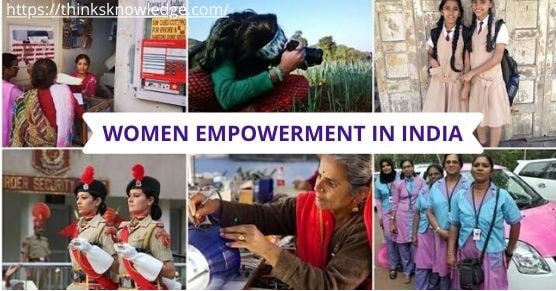Women’s empowerment means improving the social and economic status of women. So that he can get equal opportunities for employment, education, economic development, so that he can achieve social freedom and progress. This is best way the dream becomes true of women empowerment in India. As through which women can fulfill their aspirations like men.
In simple words, it will be said that women empowerment can be defined in such a way that it flows the power of women, through which they can take every decision related to their life and well in family and society. Empowering women to achieve their real rights in society is their empowerment.

THE NEED FOR WOMEN EMPOWERMENT IN INDIA
There are several reasons for the need for women empowerment in India. In the medieval period, the honor level of Indian women decreased considerably compared to the ancient period. In ancient times, the honor given to him in the medieval period began to wane.
- Socio political rights (right to work, right to education etc.) were completely restricted by male family members.
- In the modern era, many Indian women hold many important political and administrative positions, yet ordinary rural women are still obliged to live in their homes and do not have facilities like general health facilities and education.
- Women empowerment was needed as there was gender inequality in India and a male dominated society since ancient times. Women were pressurized by their own families and society for various reasons and were subjected to various forms of violence and discrimination in the family and society, which is seen not only in India but also in other countries.
- Another major reason for the need for women empowerment in India is payment disparity. One study showed that despite equal experience and qualifications, women in India are paid 20 percent less than men.
- Women in India are far behind men in India. The education rate of men in India is 81.3 percent, while the education rate of women is only 60.6 percent.
- Our country is moving forward with great speed and enthusiasm, but we can maintain it only when we are able to overcome gender inequality and ensure equal education, promotion and payment for women as men.
- Women in urban areas of India are more employable than women in rural areas, according to statistics, about 30 percent women work in software industry in cities of India, about 90 percent women in rural areas mainly Performs agriculture and allied activities on the daily wages in regions.
- Women are more open-minded and break social bonds to get their rights in all dimensions.
- Over the years, several constitutional and legal rights have been created and enforced by the government to remove gender inequality and evil practices against women. However, resolving such a big topic requires the continued support of everyone, including women.
- Modern society is more aware of the rights of women, as a result of which many self-help groups and NGOs etc. are working in this direction.
- About 50 percent of India’s population is women only, meaning half this population is required for the development of the entire country which is still not strong and is bound by many social restrictions. In such a situation we cannot say that in future our country will develop without strengthening half our population.
- In Indian society, the female goddess is worshiped as mother, sister, daughter, wife to honor women, but today it is only hypocrisy.
Some Acts passed by Parliament for Women Empowerment (Laws made by the Parliament favoring women empowerment)
Some Acts have also been passed by Parliament to empower women with legal authority. Following are those Acts: –
(i) Immoral Trade (Prevention) Act 1956
(ii) Dowry Prohibition Act 1961
(iii) Equal Remuneration Act 1976
(iv) Medical Termination of Pregnancy Act 1987
(v) Gender Testing Techniques Act 1994
(vi) Prevention of Child Marriage Act 2006
(vii) Sexual Exploitation of Women at Workplace Act 2013
PROBLEM FOR WOMEN EMPOWERMENT IN INDIA
- Social Norms
Due to old and conservative ideologies, many areas of India are prohibited from leaving their homes. In such areas, women do not have the freedom to go out of the house for education or employment. Living in such an environment, women consider themselves inferior to men and fail to change their current social and economic status.
- Physical abuse in the workplace
Exploitation in the workplace is also a major obstacle in women’s empowerment. The private sector such as service industries, software industries, educational institutions and hospitals are most affected by this problem. This creates more problems for women due to the dominance of male dominance in the society. In recent times, there has been a rapid increase in harassment of women in the field of work and about 170 percent in the last few decades.
- Gender Discrimination
Women are still discriminated against at the gender level in India. In many areas, women are not even allowed to go out for education and employment. At the same time, they do not have the freedom to work independently or to take up deficiencies related to family and are always considered inferior to men in every task. This type of discrimination worsens the social and economic status of women and also badly affects the goal of women empowerment.
- Inequality in Payments/Wages
Women in India are paid less than their male counterparts, and the problem is worse in the unorganized sector, especially in places with daily wages. Despite doing the same amount of work, women are paid far less than men, and such work shows a power disparity between women and men. Women working in the organized sector are paid less than men, despite having the same experience and qualifications as their male counterparts.
- Illiteracy
Problems such as illiteracy among women and dropping out of education are also major obstacles to women empowerment. Although in urban areas, girls are equal to boys in terms of education, but in rural areas they are far behind in this case. The female education rate in India is 64.6 percent while the education rate of men is 80.9 percent. Many rural girls who go to school also miss their education and are unable to pass even the tenth standard.
- Child marriage
Although in the last few decades, effective decisions taken by the government have drastically reduced the prevalence of child marriage in India, but in 2018, a UNICEF report states that India would still have around 1.5 million girls every year. Huh. Marriage is done before the age of 18, early development stops the development of women and she is not able to mature physically and mentally.
- Crime against women
Serious crimes like dowry, honor killing and trafficking are seen against Indian women along with many domestic violence. However, it is quite bizarre that women in urban areas suffer more from criminal attacks than women in rural areas. Even working women do not use public transport until late at night due to their safety. In the true sense, women empowerment can be achieved only when the safety of women can be ensured and like men they can come freely without any fear.
- Female feticide
Female feticide or gender-based abortion is one of the biggest obstacles in the path of women empowerment in India. Female feticide means feticide on the basis of gender, under which female feticide is aborted without the consent of the mother. Due to female aborticide, there has been a considerable difference in the sex ratio between women and men in states like Haryana and Jammu and Kashmir. These claims of our women’s empowerment will not be fulfilled until we can eradicate the problem of female feticide.
WOMEN’S EMPOWERMENT SCHEMES IN INDIA
The Government of India runs a number of schemes for women’s empowerment. Several schemes are being run by the Ministry of Women and Child Development Welfare and Government of India for the empowerment of Indian women. Some of these main schemes are mentioned below.
- Beti Bachao Beti Padhao Yojana
- The program was started in Panipat, Haryana on 22 January 2015 with the aim of promoting the survival, protection and education of the girl child.
- The purpose of this program is to make people aware of the declining sex ratio of girls.
- The overall goal of this program is to prevent discrimination between boys and girls on the basis of gender, as well as to ensure the safety, education and acceptance of each girl child.
- Ujjwala Scheme
- The scheme was launched by Prime Minister Modi on 1 May 2016.
- Under this scheme, poor women will get free LPG gas connections.
- The main objective of the scheme is to promote women empowerment and protect their health.
- Through this scheme, the government wants to increase the role of women in keeping the environment clean by promoting the use of LPG in place of fossil fuels used in cooking in rural areas.
- Support to Training And Employment Program For Women (STEP)
- The scheme was started in 1986-87 as a central scheme.
- This scheme is being run through the Ministry of Women and Child Development.
- The main objective of the scheme is to make women worthy by developing their skills so that they can get the skills to become self-employed or entrepreneurs.
- The main goal of this scheme is to develop the skills of girls / women of 16 years or above.
- Under this scheme, grants are not directly passed on to the States / Union Territories and directly to the institution / organization or even to the NGO.
- Reservation for women in Panchayati Raj schemes
- Women’s reservation in Panchayati Raj institutions provides a great example of the fact that reservation can be used as a tool for women empowerment.
- This will increase the number of women members in Parliament and State Legislatures. in present Women constitute only 11.6% in Lok Sabha and 11% in Rajya Sabha.
- Issues related to women will receive utmost priority in Parliament and they are easy Solution can be made.
- This makes the environment of Parliament and State Legislatures more debatable and discussed. Will help in making beneficial.
- States like Bihar, Uttarakhand, Madhya Pradesh and Himachal Pradesh provide 50% reservation to women in Panchayati Raj Institutions (PRIs).
- The government is considering increasing the existing 33% reservation for women in panchayats to 50%.
- Women’s Helpline Scheme
- If any woman is in trouble, then call this number, it works across the country
- The government has released numbers to help women.
- The government has released numbers to help women. Help can be obtained immediately by calling them.
- Women’s helpline number 1091/1090 is for the whole country.
- Apart from this, women can call 0111-23219750 in the National Commission for Women (NCW).
- States have also issued helpline numbers at their level.
Given the way India ranks among the fastest growing economies in the world today, India needs to focus on achieving the goal of women empowerment in the near future. It is very important that we change our old thinking against women and also change the constitutional and legal provisions.
Even though many Indian women have become presidents, prime ministers, administrative officers, doctors, lawyers etc. in today’s society, many women still need help and support. This work of women empowerment is very important because India’s socio-economic progress depends on the socio-economic progress of its women. Women empowerment empowers women, which helps them fight for their rights.
We all should respect women, give them a chance to move forward. Twenty-first centuries is the century of best possibilities in the lives of women. Women are now coming forward in every field. Today’s woman has become alert and active.
Someone has said a very good thing, “When a woman breaks a fetus and starts making relations on it, no power in the world will stop her.” Currently, women have started breaking stereotypes. This is a pleasant sign. People’s thinking is changing, yet more efforts are needed in this direction.





